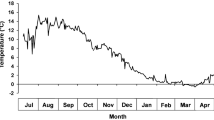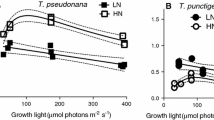Abstract
To determine how the animal and algal components of the symbiotic sea anemone Aiptasia pulchella respond to changes in food availability and culture irradiance, sea anemones from a single clone were maintained at four irradiance levels (320, 185, 115, and 45 μE m-2 s-1) and either starved or fed for 5 wk. Changes in protein biomass of sea anemones maintained under these conditions were not related to the productivity of zooxanthellae, since the protein biomass of fed A. pulchella decreased with increase in irradiance and there was no difference in protein biomass among starved sea anemones at the four irradiance levels. Except for the starved high-light sea anemones, the density of symbiotic zooxanthellae was independent of culture irradiance within both starved and fed. A. pulchella. Starved sea anemones contained over twice the density of zooxanthellae as fed sea anemones. Within both starved and fed individuals, chlorophyll per zooxanthella increased with decreasing culture irradiance while algal size remained constant (in fed sea anemones) at about 8.80 μm diameter. Chlorophyll a: c 2 ratios of zooxanthellae increased with decreasing culture irradiance in zooxanthellae from starved sea anemones but remained constant in zooxanthellae from fed sea anemones. As estimated from mitotic index data, the in situ growth rates of zooxanthellae averaged 0.007 d-1 and did not vary with irradiance or feeding regime. Photosynthesis-irradiance (P-I) responses of fed A. pulchella indicated an increase in photosynthetic efficiency with decreasing culture irradiance. But there was no consistent pattern in photosynthetic capacity with culture irradiance. Respiration rates of fed sea anemones also did not vary in relation to culture irradiance. The parameter I k , defined as the irradiance at which light-saturated rates of photosynthesis are first attained, was the only parameter from the P-I curves which increased linearly with increasing culture irradiance. The daily ratio of net photosynthesis to respiration for A. pulchella ranged from 1.6 to 2.8 for sea anemones maintained at the three higher irradiances, but was negative for those maintained at 45 μE m-2 s-1. Since the final protein biomass was greatest for sea anemones maintained at the lowest irradiance, these results indicate that sea anemone growth cannot be directly related to productivity of zooxanthellae in this symbiotic association.
Similar content being viewed by others
Literature cited
Chalker, B. E., W. C. Dunlap and J. K. Oliver: Bathymetric adaptations of reef-building corals at Davies Reef, Great Barrier Reef, Australia. II. Light saturation curves for photosynthesis and repiration. J. exp. mar. Biol. Ecol. 73, 37–56 (1983)
Chang, S. S., B. B. Prézelin and R. K. Trench: Mechanisms of photoadaptation in three strains of the symbiotic dinoflagellate Symbiodinium microadriaticum. Mar. Biol. 76, 219–229 (1983)
Clayton, W. S. Jr. and H. R. Lasker: Host feeding regime and zooxanthellal photosynthesis in the anemone, Aiptasia pallida (Verrill). Biol. Bull. mar. biol. Lab., Woods Hole 167, 590–600 (1984)
Davies, P. Spencer: The role of zooxanthellae in the nutritional energy requirements of Pocillopora eydouxi. Coral Reefs 2, 181–186 (1984)
Douglas, A. E. and D. C. Smith: The cost of symbionts to their host in green hydra. In: Endocytobiology, Vol. 2. pp 631–648. Ed. by H. E. A. Schenk and W. Schwemmler. Berlin: Walter de Gruyter 1983
Douglas, A. E. and D. C. Smith: The green hydra symbiosis. VIII. Mechanisms in symbiont regulation. Proc. R. Soc. (Ser. B) 221, 291–319 (1984)
Drew, E. A.: The biology and physiology of alga-invertebrate symbioses. II. The density of symbiotic algal cells in a number of hermatypic hard corals and alcyonarians from various depths. J. exp. mar. Biol. Ecol. 9, 71–75 (1972)
Dunn, O. J. and V. A. Clark: Applied statistics: analysis of variance and regression, 387 pp. London: J. Wiley & Sons 1974
Dustan, P.: Depth-dependent photoadaptation by zooxanthellae of the reef coral Montastrea annularis. Mar. Biol. 68, 253–264 (1982)
Falkowski, P. G. and Z. Dubinsky: Light-shade adaptation of Stylophora pistillata, a hermatypic coral from the Gulf of Eilat. Nature, Lond. 289, 172–174 (1981)
Fitt, W. K. and R. L. Pardy: Effects of starvation, and light and dark on the energy metabolism of symbiotic and aposymbiotic sea anemones, Anthopleura elegantissima. Mar. Biol. 61, 199–205 (1981)
Fitt, W. K., R. L. Pardy and M. M. Littler: Photosynthesis, respiration, and contribution to community productivity of the symbiotic sea anemone Anthopleura elegantissima (Brandt, 1835). J. exp. mar. Biol. Ecol. 61, 213–232 (1982)
Hunter, T.: The energetics of asexual reproduction: pedal laceration in the symbiotic sea anemone Aiptasia pulchella (Carlgren, 1943). J. exp. mar. Biol. Ecol. 83, 127–147 (1984)
Jassby, A. D. and T. Platt: Mathematical formulation of the relationship between photosynthesis and light for phytoplankton. Limnol. Oceanogr. 21, 540–547 (1976)
Jeffrey, S. W. and G. F. Humphrey: New spectrophotometric equations for determining chlorophylls a, c, c 1, and c 2 in higher plants, algae and natural phytoplankton in higher plants, algae and natural phytoplankton. Biochem. Physiol. Pfl. 167, 191–194 (1975)
Kevin, K. M. and R. C. L. Hudson: The role of zooxanthellae in the hermatypic coral Plesiastra urvillei (Milne Edwards and Haime) from cold waters. J. exp. mar. Biol. Ecol. 36, 157–170 (1979)
Lowry, O. H., N. J. Rosebrough, A. L. Farr and R. J. Randall: Protein measurement with the Folin phenol reagent. J. biol. Chem. 193, 265–275 (1951)
Marqhardt, D. W.: An algorithm for least-squares estimation of nonlinear parameters. J. Soc. ind. appl. Math. 11, 431–441 (1963)
McCloskey, L. R. and L. Muscatine: Production and respiration in the Red Sea coral Stylophora pistillata as a function of depth. Proc. R. Soc. (Ser. B) 222, 215–230 (1984)
Muller-Parker, G.: Photosynthesis-irradiance responses and photosynthetic periodicity in the sea anemone Aiptasia pulchella and its zooxanthellae. Mar. Biol. 82, 225–232 (1984)
Muscatine, L.: Symbiosis in marine and fresh water coelenterates. In: The biology of hydra and of some other coelenterates, pp 255–268. Ed. by H. M. Lenhoff and W. F. Loomis. Florida: University of Miami Press 1961
Muscatine, L. and E. Cernichiari: Assimilation of photosynthetic products of zooxanthellae by a reef coral. Biol. Bull. mar. biol. Lab., Woods Hole 137, 506–523 (1969)
Muscatine, L., P. G. Falkowski, J. W. Porter and Z. Dubinsky: Fate of photosynthetic fixed carbon in light- and shade-adapted colonies of the symbiotic coral Stylophora pistillata. Proc. R. Soc. (Ser. B) 222, 181–202 (1984)
Pado, R.: Mutual relation of protozoans and symbiotic algae in Paramecium bursaria. I. The influence of light on the growth of symbionts. Folia biol., Praha 13, 173–182 (1965)
Pool, R. R.: Symbiosis of Chlorella and Chlorohydra viridissima, 122 pp. Ph.D. dissertation, University of California, Los Angeles 1976
Porter, J. W., L. Muscatine, Z. Dubinsky and P. G. Falkowski: Primary production and photoadaptation in light- and shadeadapted colonies of the symbiotic coral, Stylophora pistillata. Proc. R. Soc. (Ser. B) 222, 161–180 (1984)
Sokal, R. R. and F. J. Rohlf: Biometry. The principles and practice of statistics in biological research, 776 pp. San Francisco: W. F. Freeman & Co. 1969
Steele, R. D.: Light intensity as a factor in the regulation of the density of symbiotic zooxanthellae in Aiptasia tagetes (Coelenterata, Anthozoa). J. Zool., Lond. 179, 387–405 (1976)
Svoboda, A. and T. Porrmann: Oxygen production and uptake by symbiotic Aiptasia diaphana (Rapp), (Anthozoa, Coelenterata) adapted to different light intensities. In: Nutrition in the Lower Metazoa, pp 87–99. Ed. by D. C. Smith and Y. Tiffon. New York: Pergamon Press (1980)
Szmant-Froelich, A. and M. E. Q. Pilson: The effects of feeding frequency and symbiosis with zooxanthellae on the biochemical composition of Astrangia danae Milne Edwards and Haime 1848. J. exp. mar. Biol. Ecol. 48, 85–97 (1980)
Taylor, D. L.: On the regulation and maintenance of algal numbers in zooxanthellae-coelenterate symbiosis, with a note on the nutritional relationship in Anemonia sulcata. J. mar. biol. Ass. U.K. 49, 1057–1065 (1969)
Titlyanov, E. A., M. G. Shaposhinikova and V. I. Zvalinskii: Photosynthesis and adaptation of corals to irradiance. 1. Contents and native state of photosynthetic pigments in symbiotic microalga. Photosynthetica 14, 413–421 (1980)
Wethey, D. S. and J. W. Porter: Sun and shade differences in productivity of reef corals. Nature, London. 262, 281–282 (1976)
Wilkerson, F. P., G. Muller Parker and L. Muscatine: Temporal patterns of cell division in natural populations of endosymbiotic algae. Limnol. Oceanogr. 28, 1009–1014 (1983)
Yonge, C. M. and A. G. Nicholls: Studies on the physiology of corals. V. The effect of starvation in light and darkness on the relationship between corals and zooxanthellae. Scient. Rep. Gt Barrier Reef Exped. 1, 177–211 (1931)
Zvalinskii, V. I., V. A. Leletkin, E. A. Titlyanov and M. G. Shaposhnikova: Photosynthesis and adaptation of corals to irradiance. 2. Oxygen exchange. Photosynthetica 14, 422–430 (1980)
Author information
Authors and Affiliations
Additional information
Communicated by J. M. Shick, Orono
Rights and permissions
About this article
Cite this article
Muller-Parker, G. Effect of feeding regime and irradiance on the photophysiology of the symbiotic sea anemone Aiptasia pulchella . Marine Biology 90, 65–74 (1985). https://doi.org/10.1007/BF00428216
Accepted:
Issue Date:
DOI: https://doi.org/10.1007/BF00428216




